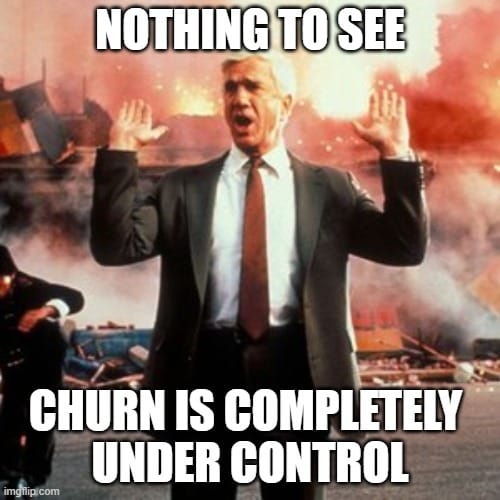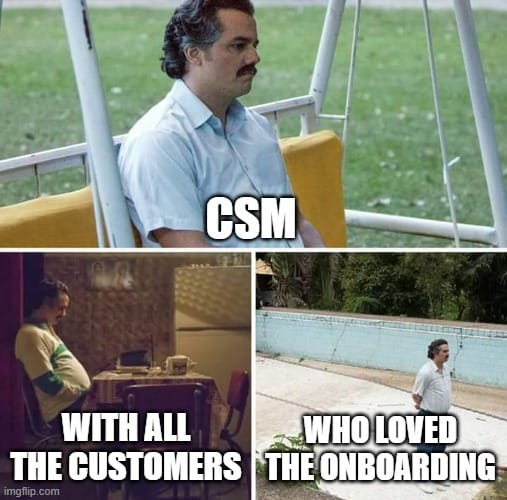Sponsored by

Provide expert-led, enterprise-level results for scaled customers.

Get ready for a showdown like no other! We’re bringing together two Customer Success titans - Nick Mehta, CEO of Gainsight, and Jay Nathan, COO of Churnkey - hosted by Greg Daines, CEO of ChurnRX, for an epic head-to-head debate on the future of Customer Success.
Join us as these industry powerhouses tackle the biggest questions on the state of Customer Success and share game-changing insights to drive customer revenue.
This is the debate everyone’s talking about—are you in?

Hi, Markus here. Welcome to a free edition of the Customer-Value-Led-Growth Newsletter.
Every week, I share strategies, guides, and frameworks to help you create exceptional value for your customers and company.
If you are not a paid subscriber, here’s what you might have missed:
and 100+ other episodes 🔥
Consider subscribing to get the full experience and support my work 👇
Reducing churn and improving customer retention is more important than ever. People need guidance on how to keep their customers using and paying for their products.
But the quality of the material they can find is really poor. It starts with the “classics”. They are told that customers are leaving because the price is too high or competitors have better offers.
Ok, so if that was true why did these customers choose your product in the first place? They knew the price in advance and they compared different offers. These are proxy reasons masking a different problem.
Then you find articles or ebooks called “x proven customer retention strategies” sharing gems like
personalize customer interactions - wow, that’s genius
celebrate customers’ success - ok, so customers leave despite being successful when you don’t celebrate together?
incentivize referrals - in what universe does that make sense?
I’m so tired of reading this unqualified advice that keeps people throwing random tactics at churn hoping something sticks.
The only way to eliminate churn sustainably is to understand and eliminate its root causes.

Introduction
If we are looking at churn from birds eye perspective it happens for 2 reasons:
External Events: Customers are going out of business or they are getting acquired and are integrated into the buyers’ tech stack. These are out of your control and it does not make sense to worry about it.
Lack of Value: Customers are buying your product to increase their revenue, reduce costs, improve their productivity, etc. If they don’t get what they came for, they are leaving. This is where you need to pay close attention.
Adopting this customer-centric view on churn will help you to
stop settling for proxy reasons customers give
stop making excuses like blaming it on the market
avoid making bad decisions like trying to bribe customers with discounts
While there’s only one reason why customers churn I distinguish between 7 root causes you will learn about now
1. The Wrong Expectations
Customers want to win. They want to win big and they want to win fast. Of course, you can make the magic happen, can’t you?
If customers come with the wrong expectations about the
magnitude of possible results
time it takes to get there
effort required from their side
you have acquired churn. There’s potentially a 1% chance that you can talk customers into settling for less than what has been initially promised.
The worst thing about this situation is that your customers likely feel tricked into buying which is, unsurprisingly, bad for your reputation.
Customer expectations are often misled by sales reps to close more deals. However, this is not a sales but a management problem caused by bad policies and incentive structures.
But it’s also happening because sales reps don’t know better. They sell what they think is possible.
CSMs can address this problem by proactively sharing accurate information about what can be accomplished and what can’t.
2. Lack of Customer Product Fit
If customers come with the wrong expectations they will never be successful. But that does not mean every customer who comes with accurate ones is going to be successful.
Some of them simply don’t have enough success potential. They don’t have the required skills, discipline, attitude, etc. it takes to accomplish their goals. It’s just wishful thinking.
I’m talking about skills that can’t be taught or don’t make sense to teach them.
You are selling marketing software. Using your product successfully requires proper project management skills. Do you want to teach customers without on top of how to do great marketing? Doesn’t make much sense.

The solution to this problem is to improve the qualification process by identifying patterns within your existing customer base.
You need to find out what your best and your worst (former) customers have in common. If you understand how both groups - sticking with the example - run marketing projects then you can qualify potential new buyers based on it.
You know what you are looking for and you know what are the red flags.
3. Poor Product Usability
I’m assuming your product is what it is and does what is intended to do. So technically, you have a product that works for your customers. But if it’s clunky and cumbersome people will still be turned off.
They are used to certain standards. Meeting them does not make you win but failing to do so is going to make you lose. When customers mention the product as the reason why they are leaving you must understand what that means exactly.
Staring at a report that outlines what features they used and which they did not isn’t going to cut it. You need to hear from customers firsthand to understand the context behind their usage patterns.
As a CSM you are best qualified to conduct these interviews because you understand how your product works and you also know the customer use case.
4. Product Stability Issues
A great product design can be nullified completely when it’s suffering from frequent bugs or downtimes. When customers are losing their progress over the last 15, 30, or 60 minutes they become highly frustrated.
It’s understandable, we can all relate to it. I’ve experienced it several times. If it happens earlier in the journey it’s even worse as you are not quick to reproduce it. If it happens during the onboarding it’s probably game over already.
There’s no such thing as a perfect product that is free of bugs. At least, none I have heard about yet. This is also not the point. The point is to get them an absolute minimum before adding new features and making things even worse.
5. Underperforming Customer Support
Customer Success Management and Customer Support are not the same. They are complements. CSM helps customers to accomplish their business outcomes. Support helps them to operate the product and their accounts smoothly.
Great Customer Support does not make customers successful. But bad customer support makes them stop using the product before they have a shot at seeing success.
If it takes 10 forth and back Emails, trying 5 different things, and the customer issue is still not resolved after a week it’s no surprise when customers are leaving. But that’s becoming irrelevant because of AI anytime soon, doesn’t it?
Speaking from personal experience, it hasn’t worked for me on even a single occurrence. Before I reach out for help I try to solve my issues myself.
So when I eventually do reach out, what does the AI provide me with? It points me exactly to the things I have already tried.
The key to great customer support is crystal clear to me whether it’s human or machine: Understand my issue exactly and provide me the right solution.
6. Failed Customer Onboarding
There’s no chance for a second first impression. After your customers have purchased your product you have to deliver on the promises made before.
The goal of customer onboarding is not to introduce customers to features and functions. It’s to give them quick wins to verify their purchase decision and earn their commitment to playing the long game.
But what happens at many companies instead is this: Customers sign up, click around a while, leave, and are never seen again. One reason why this is happening is because they only realize after the purchase that it’s not the right choice.
The other reason is that they are getting nowhere. There’s either
no onboarding at all and customers need to figure out everything on their own
it ends with the technical part (importing data, account settings, etc.)
customers get overwhelmed with inputs
or they don’t get the inputs they need for their particular use case

It’s hard to say which one happens more often. I have never experienced a great customer onboarding to any of the products I have signed up for. Some have been decent but most were really poor.
7. Broken Success Journey
Despite the best intentions and preparations, customers might still not be able to accomplish their goals. I’ve noticed a tendency in CSM to blame all churn on product issues and customer quality.
But looking inside of CSM at dozens of SaaS companies I can say that a lot of churn is caused entirely by yourself. These are the top 4 reasons why CSM efforts fail to produce the intended results:
Lack of customer discovery - you built your CS plans based on the superficial information in the sales handoff
Inaccurate success plans - you did not create a roadmap that outlines the steps customers need to take to accomplish their goals
Low content and service quality - your inputs do not equip customers with the skills and knowledge they need to succeed
Poor risk management - you are not tracking customer progress and fail to detect deviations from the success path in time
and most of the time it’s not one but all of them. This is not a surprise because they are all part of the same bigger problem - lack of customer centricity.
Here’s how I can be of further help:
CSM Academy: Become 1% better at delivering, growing, and monetizing customer value in less than 5 minutes per day.
Courses and Guides: Get the strategies, tools, and processes to move from reactive CSM to Customer Value-Led Growth.
Services: Keynotes, Workshops, and the full implementation of the Customer Value-Led Growth Framework
Sponsorships: Promote your product, service, content or event to 6.4k+ CS professionals by sponsoring this newsletter
